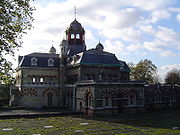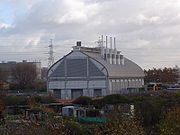
Abbey Mills Pumping Station
Encyclopedia

London
London is the capital city of :England and the :United Kingdom, the largest metropolitan area in the United Kingdom, and the largest urban zone in the European Union by most measures. Located on the River Thames, London has been a major settlement for two millennia, its history going back to its...
E15, is a sewerage
Sewerage
Sewerage refers to the infrastructure that conveys sewage. It encompasses receiving drains, manholes, pumping stations, storm overflows, screening chambers, etc. of the sanitary sewer...
pumping station
Pumping station
Pumping stations are facilities including pumps and equipment for pumping fluids from one place to another. They are used for a variety of infrastructure systems, such as the supply of water to canals, the drainage of low-lying land, and the removal of sewage to processing sites.A pumping station...
, designed by engineer Joseph Bazalgette
Joseph Bazalgette
Sir Joseph William Bazalgette, CB was an English civil engineer of the 19th century. As chief engineer of London's Metropolitan Board of Works his major achievement was the creation of a sewer network for central London which was instrumental in relieving the city from cholera epidemics, while...
, Edmund Cooper, and architect Charles Driver
Charles Henry Driver
Charles Henry Driver was a significant British architect of the Victorian era, with a reputation for pioneering use of ornamental iron work for which he was seen as a leading authority. He was also an expert in its casting and manufacture. He consulted in this area for Joseph Paxton on The Crystal...
. It was built between 1865 and 1868. It was designed in a cruciform plan, with an elaborate Byzantine style, described as The Cathedral of Sewage. It has a twin, Crossness Pumping Station
Crossness Pumping Station
Crossness Pumping Station was a sewage pumping station designed by engineer Sir Joseph Bazalgette and architect Charles Henry Driver. It was constructed between 1859 and 1865 as part of his redevelopment of the London sewerage system...
, south of the River Thames
River Thames
The River Thames flows through southern England. It is the longest river entirely in England and the second longest in the United Kingdom. While it is best known because its lower reaches flow through central London, the river flows alongside several other towns and cities, including Oxford,...
at Crossness
Crossness
Crossness is a place in south-east London. It is situated in the London Borough of Bexley, close to the southern bank of the River Thames, to the east of Thamesmead, west of Belvedere and north-west of Erith. The place takes its name from Cross Ness, a specific promontory on the southern bank of...
, at the end of the Southern Outfall Sewer
Southern Outfall Sewer
The Southern Outfall Sewer is a major sewer taking sewage from the southern area of central London to Crossness in south-east London. Flows from three interceptory sewers combine at Deptford and then run under Greenwich, Woolwich, Plumstead and across Erith marshes...
.
History
The pumping station was built at the site of an earlier watermillWatermill
A watermill is a structure that uses a water wheel or turbine to drive a mechanical process such as flour, lumber or textile production, or metal shaping .- History :...
owned by the local Abbey, from which it gained its name
Purpose
The pumps raised the sewageSewage
Sewage is water-carried waste, in solution or suspension, that is intended to be removed from a community. Also known as wastewater, it is more than 99% water and is characterized by volume or rate of flow, physical condition, chemical constituents and the bacteriological organisms that it contains...
in the London sewerage system
London sewerage system
The London sewerage system is part of the water infrastructure serving London. The modern system was developed during the late 19th century, and as London has grown the system has been expanded.-History:...
between the two Low Level Sewers and the Northern Outfall Sewer
Northern Outfall Sewer
The Northern Outfall Sewer is a major gravity sewer which runs from Wick Lane in Hackney to Beckton Sewage Works in east London ; most of it was designed by Joseph Bazalgette after an outbreak of cholera in 1853 and "The Big Stink" of 1858.Prior to this work, central London's drains were built...
, which was built in the 1860s to carry the increasing amount of sewage produced in London
London
London is the capital city of :England and the :United Kingdom, the largest metropolitan area in the United Kingdom, and the largest urban zone in the European Union by most measures. Located on the River Thames, London has been a major settlement for two millennia, its history going back to its...
away from the centre of the city.
Two Moorish styled chimneys – unused since steam power had been replaced by electric motors in 1933 – were demolished in 1941, as it was feared that a bomb strike from German
Germany
Germany , officially the Federal Republic of Germany , is a federal parliamentary republic in Europe. The country consists of 16 states while the capital and largest city is Berlin. Germany covers an area of 357,021 km2 and has a largely temperate seasonal climate...
bombs might topple them on to the pumping station.
The building still houses electric pumps – to be used in reserve for the new facility next door.
The main building is grade II* listed and there are many grade II listed ancillary buildings, including the stumps of the demolished chimneys.
The modern pumping station

Allies and Morrison
Allies and Morrison is a London-based architectural practice founded by Bob Allies and Graham Morrison in 1984. The practice is now headed up by 10 Partners and employs around 210 people in their purpose designed studios at 85 Southwark Street...
. The old building (Station A) has electrical pumps for use as a standby; the modern station is one of the three principal London pumping stations dealing with foul water.
One of world's largest installation of drum screens to treat sewage was constructed as part of the Thames Tideway Scheme
Thames Tideway Scheme
The Thames Tideway Scheme is an infrastructure project intended to improve the capacity of London’s sewerage system and prevent sewage overflows into the River Thames on the Tideway where it flows through London....
. The site is managed and operated by Thames Water
Thames Water
Thames Water Utilities Ltd, known as Thames Water, is the private utility company responsible for the public water supply and waste water treatment in large parts of Greater London, the Thames Valley, Surrey, Gloucestershire, Wiltshire, Kent, and some other areas of in the United Kingdom...
.
Lea tunnel
Thames Water are boring a sewage tunnel from Abbey Mills to Beckton Sewage Works to handle the 16 million tons of overflow sewage that is discharged into the River Lea each year. Construction is expected to be completed in 2013, and the tunnel boring machineTunnel boring machine
A tunnel boring machine also known as a "mole", is a machine used to excavate tunnels with a circular cross section through a variety of soil and rock strata. They can bore through anything from hard rock to sand. Tunnel diameters can range from a metre to almost 16 metres to date...
's name, 'Busy Lizzie', was chosen via a competition open to local school children.
Etymology
Abbey Mills derives its name from the site of Stratford Langthorne AbbeyStratford Langthorne Abbey
Stratford Langthorne Abbey, or the Abbey of St Mary's, Stratford Langthorne was a Cistercian monastery founded in 1135 at Stratford Langthorne — then Essex but now Stratford in the London Borough of Newham...
, which lay between the Channelsea River
Bow Back Rivers
The Bow Back Rivers are part of the River Lea in the London Borough of Newham, east London, England, and form a complex system of waterways. The River Lea was originally tidal as far as Hackney Wick; man-made changes to the river had changed this dramatically in the 9th century, and in 1110 a...
and Marsh Lane (Manor Road). The Abbey was dissolved
Dissolution of the Monasteries
The Dissolution of the Monasteries, sometimes referred to as the Suppression of the Monasteries, was the set of administrative and legal processes between 1536 and 1541 by which Henry VIII disbanded monasteries, priories, convents and friaries in England, Wales and Ireland; appropriated their...
in 1538. By 1840, the North Woolwich railway
North London Line
The North London Line is a railway line which passes through the inner suburbs of north London, England. Its route is a rough semicircle from the south west to the north east, avoiding central London. The line is owned and maintained by Network Rail...
ran through the site, and it began to be used to establish factories, and ultimately the sewage pumping stations.
As a film location
The pumping station (Station A) was used as the location for the "Cosy PrisonsCosy Prisons
The third single "Cosy Prisons" from the A-ha album Analogue was released in the UK on 6 April 2006.The UK single features a new mix of the song which was worked on by Magne Furuholmen and Dave Bascombe...
" video shoot by Norwegian
Norway
Norway , officially the Kingdom of Norway, is a Nordic unitary constitutional monarchy whose territory comprises the western portion of the Scandinavian Peninsula, Jan Mayen, and the Arctic archipelago of Svalbard and Bouvet Island. Norway has a total area of and a population of about 4.9 million...
pop band a-ha
A-ha
A-ha were a Norwegian pop band formed in Oslo in 1982. The band was founded by Morten Harket , Magne Furuholmen , and Pål Waaktaar...
on 4 March 2006, and also represented Arkham Asylum
Arkham Asylum
The Elizabeth Arkham Asylum for the Criminally Insane, commonly referred to simply as Arkham Asylum, is a fictional psychiatric hospital in the DC Comics Universe, usually appearing in stories featuring Batman...
in the 2005 film Batman Begins
Batman Begins
Batman Begins is a 2005 American superhero action film based on the fictional DC Comics character Batman, directed by Christopher Nolan. It stars Christian Bale as Batman, along with Michael Caine, Gary Oldman, Liam Neeson, Katie Holmes, Cillian Murphy, Morgan Freeman, Ken Watanabe, Tom Wilkinson,...
.

